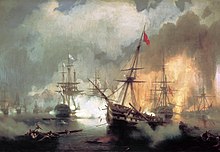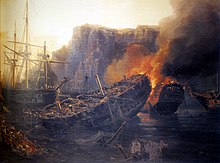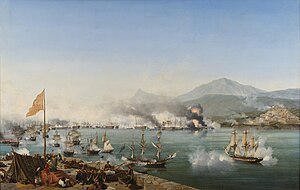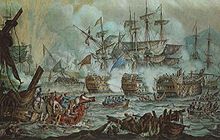Battle of Navarino
| date | October 20, 1827 |
|---|---|
| place | Navarino , Greece |
| output | Decisive defeat of the Ottomans |
| consequences | Renewal of the armistice and withdrawal of the Ottoman-Egyptian army |
| Parties to the conflict | |
|---|---|
| Commander | |
|
|
|
| losses | |
|
Great Britain: 80 dead, 206 wounded Russia: 59 dead, 159 wounded France: 43 dead, 144 wounded Total: 182 dead, 489 wounded |
approx. 4,000 dead and missing |
The Battle of Navarino (also Battle of Navarino ) was a sea battle and took place on October 20, 1827 off the southwest coast of the Peloponnese . It was the decisive event with which Greece achieved its independence from the Ottoman Empire after a year-long uprising .
prehistory
By a Treaty of London signed on July 6, 1827, the United Kingdom , France and Russia agreed to demand an armistice in preparation for a final settlement of the Oriental question . Sir Edward Codrington , the Commander in Chief of the British Navy in the Mediterranean , received the treaty and its instructions on the night of 10/11. August in Smyrna (today Izmir) and immediately went to Nauplia to inform the Greeks. His instructions were to demand a ceasefire, to intercept all supplies from Africa or generally from the Ottoman Empire to the troops in Morea (now the Peloponnese) and to pay attention to instructions for Stratford Canning , the English ambassador in Constantinople. The ambassador's instructions reached Codrington on September 7th. He was accompanied to Nauplia by his French colleague, Rear Admiral de Rigny . The Greek government agreed to the armistice. Admiral de Rigny was leaving for a cruise in the Levant .

Codrington, who had heard that an Egyptian navy - Egypt was Ottoman at the time - was headed for Alexandria and believed it was heading for Hydra , set out for that island, which he reached on September 3rd. On September 12th he found the Egyptians with a Turkish squadron at anchor near Navarino ( Pylos ). The Ottoman government rejected the armistice. On September 19, Codrington saw movements among the Egyptian and Turkish ships in the bay and informed the Ottoman Admiral Tahir Pasha that he had orders to stop any hostile action against the Greeks. Admiral de Rigny immediately followed suit, and together they sent a note on September 22nd to Ibrahim Pasha , who was in command of the Sultan. On the 25th there was an interview in which Ibrahim gave an oral assurance that he would not act against the Greeks while he awaited orders from the Sultan. The Allies parted now that their supplies were running low; Codrington went to Zante and de Rigny to Cervi, where his supply ships were moored. Frigates were left to watch Navarino. The British admiral had barely anchored at Zante when he was informed that the Sultan's forces were leaving. On September 29th, a Greek fleet, commanded by the English philhellenic Frank Abney Hastings , had destroyed some Turkish ships in the bay of Salona , on the north side of the Corinthian Gulf .

Codrington, who only had his flagship, the HMS Asia , and a few smaller ships at his disposal, needed the days from October 3rd to 5th to return to the Egyptian and Turkish ships, but a violent storm helped him . He resumed his watch at Navarino, and on October 13th de Rigny and the Russian Rear Admiral Heiden and his squadron arrived at his place. By a general agreement between the Allies, Codrington's command was entrusted.
The Allied fleet was eleven ships of the line , nine frigates and four smaller ships (three British, four French and four Russian ships of the line, if one counts the flagship of the French admiral, the Sirène - also four British, one French and four Russian frigates). The Egyptians and Turks had three ships of the line, nineteen large frigates and 35 smaller ships.
If Ibrahim Pasha was unable to operate at sea, he continued the war on land. The flames and smoke from destroyed villages could be seen by the crews of the Allied fleet. On October 17th, a joint protest note was sent to Ibrahim Pasha, but came back with the apparently incorrect answer that he had left Navarino and that his officers did not know where he was. The admirals therefore decided to steer into the bay and anchor between the Ottoman ships. A French officer named Letellier in Egyptian service had anchored Ibrahim's ships and those of the Turkish admiral in a horseshoe formation whose endpoints touched the entrance to the bay. There were fortresses on land on either side of the driveway. The Allies drove in two lines - one formed by the French and British under Codrington on the Asia , the other by the Russians - and began to anchor in the open water amid Ibrahim's fleet.
On the night of October 19-20, 1827, the Austrian schooner "Enrichetta" arrived in Navarino and passed the Allied blockade fleet unseen and penetrated the bay. Captain Logotheti anchored in a small bay to observe the situation.
course
Captain Fellowes, who commanded the British frigate Dartmouth , saw a Turkish fire windward and sent a boat with the order that the ship should be removed. The Turks opened fire, killing a lieutenant who delivered the message and some of the boat's crew. The Dartmouth then opened "defensive fire", whereupon the battle broke out immediately.
The Allies, all closely involved in combat, had anchored between the enemy and benefited from their heavier broadsides and better cannons. The behavior of the captain who commanded the British cutter HMS Hynd is remarkable . He lined up next to the British flagship in the battle line and tirelessly fired at the Turkish ships with his four cannons on the starboard side. This earned the small ship the honorary title of "Her Majesty's Line Cutter". Three quarters of the Turkish and Egyptian ships were sunk by the attackers or set on fire by their own crew. On the Allied side, 75 English were killed and 197 wounded, 43 French killed and 183 wounded, and 59 Russians killed and 139 wounded. In the British squadron, Captain Walter Bathurst was slain by HMS Genoa . The losses on the Ottoman side are not precisely recorded, but they were certainly high. The Battle of Navarino was the last major sea battle exclusively with sailing ships.
Ships involved
| Great Britain | France | Russia | Allies | Ottomans and Egyptians | total | |
|---|---|---|---|---|---|---|
| Ships of the line |
HMS Asia (FF) (84) HMS Genoa (76) HMS Albion (74) |
Wroclaw (84) Scipion (80) Trident (74) |
Gangut (84) Azov (F) (80) Iezekiil (80) Aleksandr Nevskii (80) |
10 (796) |
Ghiuh Rewan (FF) (84) Fahti Bahri (F) (74) Burj Zafer (70) |
3 (228) |
| Frigates |
HMS Glasgow (50) HMS Cambrian (48) HMS Dartmouth (42) HMS Talbot (28) |
Sirène (F) (dd) (60) Armide (44) |
Provornyi (48) Konstantin (44) Elena (38) Castor (36) |
10 (438) |
Ihsanya (dd) (64) Surya (dd) (56) Guerrière (F) (dd) (60) Leone (dd) (60) Fevz Nusrat (dd) (64) Ka'íd Zafer (dd) (64) 1 Other dd 10 single deck frigates |
17 (818) |
| Other* |
HMS Hynd ( cutter ) (10) 1 Corvette (18) 3 Briggs (10) |
2 schooners (10-16 / 6) | 7 (74) | 30 Corvettes 28 Briggs |
58 (1134) | |
| Total | 14th | 7th | 8th | 29 (1308) | 78 | 78 (2180) |
(dd) Double deck
Source: William James: The Naval History of Great Britain. From the declaration of war by France in 1793, to the accession of George IV. Bentley, London 1837, Vol. 6, pp. 476-489.
Effects

The naval battle of Navarino was important for the further history of the Ottoman Empire and thus both Europe and the Middle East. Not only did it undermine the efforts of the Turks to suppress the Greek revolt, but it also caused a rupture in traditionally good relations between the United Kingdom and the Ottoman Empire. Its effects were evident in the critical phase of the conflict between Muhammad Ali Pasha and the Sublime Porte (1831–1841). Navarino accelerated the Russo-Turkish War of 1828-29 , and the annihilation of the Ottoman Navy weakened the Ottomans' defensive strength against the Russian Empire and later against Muhammad Ali.
Trivia
A large number of bronze cannons had sunk with the Egyptian-Turkish fleet. A large part of it was raised under the Greek King Otto and sold as recycling material in Europe, some of which ended up in Bavaria and was used for the casting of the obelisk on Karolinenplatz in Munich , the Bavaria and the Tilly statue in the Feldherrnhalle .
Individual evidence
- ↑ Oliver Warner: Great Sea Battles . Spring Books, London 1968, p. 215.
literature
- William James : The Naval History of Great Britain. A New Edition, with Additions and Notes, and an Account of the Burmese War and the Battle of Navarino . Bentley, London 1837, Vol. 6, The Battle of Navarin , pp. 471-490.
- Ralf-Peter Märtin : Navarino - the battle that nobody wanted. In October 1827 the Sultan lost his fleet ("Zeitlichte" series). In: Die Zeit , vol. 53 (1997), no. 42.
- Lawrence Sondhaus: Naval Warfare 1815-1914. Routledge, London 2001. ISBN 0-415-21477-7
- Christopher Montague Woodhouse : The battle of Navarino . Hodder & Stoughton, London 1965.



